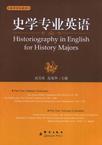史学专业英语
2008-9
群言出版社
高芳英,范菊华 主编
241
本教材通过世界历史和中国历史两条主线,以为学生提供一本编年简史类的专业英语教材。书中的选材涉及了政治、经济、战争、条约、宗教、科学技术、文化思想等广泛的领域;教材精选了部分原始文档,节选了部分国外和国内著名历史学家和政治家的英文原版论著和英译名著,强化了史学的学术性和英语语言的学术性。本教材分两大部分:世界史22章,中国史12章。每章开始简单介绍本章涵盖内容,主体由两部分组成:A.某段通史资料;B.文献史料或论著节选。随后有历史和语言难点的注释,最后是思考问答题和翻译练习题。
高芳英,硕士,1956年生,女,江苏苏州人。历史学教授。先后毕业于苏州大学、美国克利夫兰州立大学,1996年、1999年、2002年赴美国、英国留学和访学。主要从事世界史的教学和研究工作,专业重点是美国史和近现代世界经济史,出版专著《星条旗下的阴影——美国百年经济发展中的社会问题探析》、编著《世界地理大发现》,在《世界历史》、《江海学刊》、《史林》等核心期刊发表论文几十篇,科研成果多次获得市厅级二、三等奖,被苏州市政府列为跨世纪人才。现任苏州大学社会学院历史系副主任、世界史专业硕士生导师、中国日本史学会常务理事兼对外交流分会会长,江苏省世界史研究会副会长。范菊华,博士1962年生,男,江苏苏州人。历史学副教授。先后从事中小学英语教学,大学英语和历史专业教学,并先后获英语语言文学硕士和历史学博士学位,现任苏州大学社会学院历史系硕士生导师,承担世界历史,当代国际关系和史学专业英语等课程的教学。研究方向为二十世纪国际关系、国际关系史学与理论,主治西方国际关系理论和全球气候变化,出版专著《国际制度的建构主义分析》,在《世界经济与政治》、《现代国际关系》、《国外社会科学》、《读书》等刊物发表论文数篇。
PrefacePart One Western CivilizationⅠ The Ancient World: Foundations of the West To A. D. 500 1 The Ancient Near East: The First Civilizations 2 The Greeks: From Myth to Reason 3 The Romans: From City-State to World Empire 4 Early Christianity: A World ReligionⅡ The Middle Ages: The Christian Centuries A. D. 500~1400 5 The Rise of Europe: Fusion of Classical, Christian, and German Traditions 6 The Flowering of Medieval Civilization: The Christian SynthesisⅢ The Rise of Modernity: From the Renaissance to the Enlightenment 1350 ~1789 7 Transition to the Modern Age: Renaissance and Reformation 8 Political and Economic Transformation: National States, Overseas Expansion,Commercial Revolution 9 Intellectual Transformation: The Scientific Revolution and the Age of EnlightenmentⅣ The Modern West: From the Bourgeoisie Revolution to the Industrial Age 1640~1914 10 The Triumph of England's Parliament: Constitutional Monarchy and Cabinet Government 11 The American Revolution: Independence and Civil War 12 The Era of the French Revolution: The Affirmation of Liberty and Equality 13 Ferment of Ideas: Romanticism, Conservatism, Liberalism, Nationalism 14 The Industrial Revolution: The Transformation of Society 15 Europe in the Industrial Age: Modernization and ImperialismⅤ Western Civilization in Crisis: World Wars and Totalitarianism 1914~1945 16 World War I: The West in Despair 17 The Soviet Union: Modernization and Totalitarianism 18 The Era of Fascism: The Attack on Reason and Freedom 19 World War II: Western Civilization in the BalanceⅥ The Contemporary World: The Global Age Since 1945 20 Europe After 1945: Recovery, Realignment, Division 21 U.S. After 1945: Hegemonic Position 22 The New Globalism: Problems and ProspectsPart Two Chinese CivilizationⅠ Ancient Chinese Civilization: One of the Four Great Ancient Civilizations 1 Four Great Inventions: the Compass, Gunpowder, Papermaking,and Printing 2 Three Schools of Thoughts in Ancient: Confucianism, Taoism, Buddhism 3 The First Emperor of Imperial China: Qin Shi Huangdi 4 The Greatest Dynasty of Imperial China: Hen Dynasty 5 The Classical Literature: The Poetry in Tang and Song DynastiesⅡ Emergence of Modern China: The Semi-Colonial and Semi-Feudalism China 6 The Opium War: Western Powers Arrive 7 The Growing up of the Chinese Modem History: The Self-Strengthening Movement 8 The Revolution of 1911 : Turning Point in Modern Chinese HistoryⅢ Modern Chinese Polities: From “Dark” to ”Bright” 9 The New Culture Movement: the Basis for May Fourth Movement 10 Rise of the Communists: Leader Mao Zedong 11 Anti-Japanese War: Kuomintang and CCP United Front Against Japan 12 Civil War: the Triumph of Communist PartyMain ReferencesPostscript
A.The PolisAfter the upheavals that ended the Mycenaean period and the slow recovery of prosperityduring the Dark Age,the Greeks developed their basic political and institutional unit,thepolis or city-state.The details of this development are largely lost,but by the end of theDark Age the polis was common throughout Greece.Rarely did there.occur the combination of extensive territory and political unity that allowed one polis to rise above others.Onlythree city-states were able to muster the resources of an entire region behind them:Sparta,which dominated the regions of Laconia and Messenia;Athens,which united the large peninsula of Attica under its rule;and Thebes,which in several periods marshaled theresources of the fertile region of Boeotia.Otherwise,the political pattern of ancient Greece was one of many small city-states,few of which were much songer or richer than their neighbors.Physically the term polls designated a city or town and its surrounding countryside.Thetypical polis consisted of people living in a compact group of houses within the city.The city’s water supply came from public fountains and cisterns.By the fifth century B.C.the city was generally surrounded by a wall.The city contained a point,usually elevated,called the“acropolis.”and a public square or marketplace(agora).On the acropolis,which in the early period was a place of refuge,stood the temples,altars,public monuments,and various dedications to the gods of the polis.The agora was originally the place where the warrior assembly met,but it became the political center of the polis.In the agora were porticoes,shops,and public buildings and courts.The polis was far more than a political institution.Above all it was a community of citizens.and the affairs of the community were the concern of all citizens.The intimacy ofthe polis was an important factor,one hard for modern city dwellers to imagine.The philosopher Plato thought that five thousand citizens constituted the ideal population for a polis.Though utopian,Plato was not in this case being unrealistic.Although populationfigures for Greece are mostly guesswork,because most city-states were small enough not to need a census.the polis of Thebes in Boeotia is a useful illustration of how small a Greek state was.When Alexander the Great destroyed Thebes in 335 B.C.,he sold thirty thousand people into slavery.Some six thousand people had died in the fighting,and many others he spared.Thus the free population of Thebes had numbered between thirty and forty thousand at most,and Thebes was a large polis,a major power.
本教材的编写得益于我在美国的留学。在美国克利夫兰大学留学期间,接触到了许多世界历史的原始资料,专业英语的水平也有了很大的提高。美国克利夫兰大学历史系曾赠送给我系一些历史书籍,正是有了这些宝贵的专业书籍,才使教材的编写比较顺利。今天在教材完稿之际,要特别感谢我美国的老师和这些书籍的作者。另外,我的同事范菊华老师,是获得英语语言文学硕士和历史学博士学位的双料学者,我们俩的合作为本教材的顺利编写奠定了重要的基础。本教材各章编写分工如下:世界史部分:第1-9,11,13,21章,高芳英;第10,12,14-20章的简单介绍和A部分及部分注释和思考问答题,高芳英;第10,12,14-20章的B部分及部分注释和翻译练习题,范菊华;第22章,范菊华。中国史部分:第l-6章,范菊华;第6-12章,高芳英。前言和后记,高芳英。
《史学专业英语》由群言出版社出版。

其中所选的都是历史名著中的篇章,但是有的地方印刷有误,不过对我个人的史学英语的学习有很大的帮助,对英语阅读能力的提高也确实很有效用,很不错。
一本书浓缩了世界史、中国史,是学习历史英语的好书。适合教师和学生学习。
我今天才拿到分书。。随手翻了翻,还行吧。。跟我们学过的几篇专业英语难度差不多。。我没有看过别人出版的此种商品没有什么比较。。只是对这门课比较感兴趣,老师没有订课本。。所以买来看看。。书质量很不错。。
真心看不懂啊。虽然是英文版的西方通史和中国通史。。。
适合学习历史的人掌握英语,注释不多,专业性强。
内容很一般,没有多少历史知识
书是旧的,但没有破损。原书主在书中标记的东西比较多,还可以还可以~~~